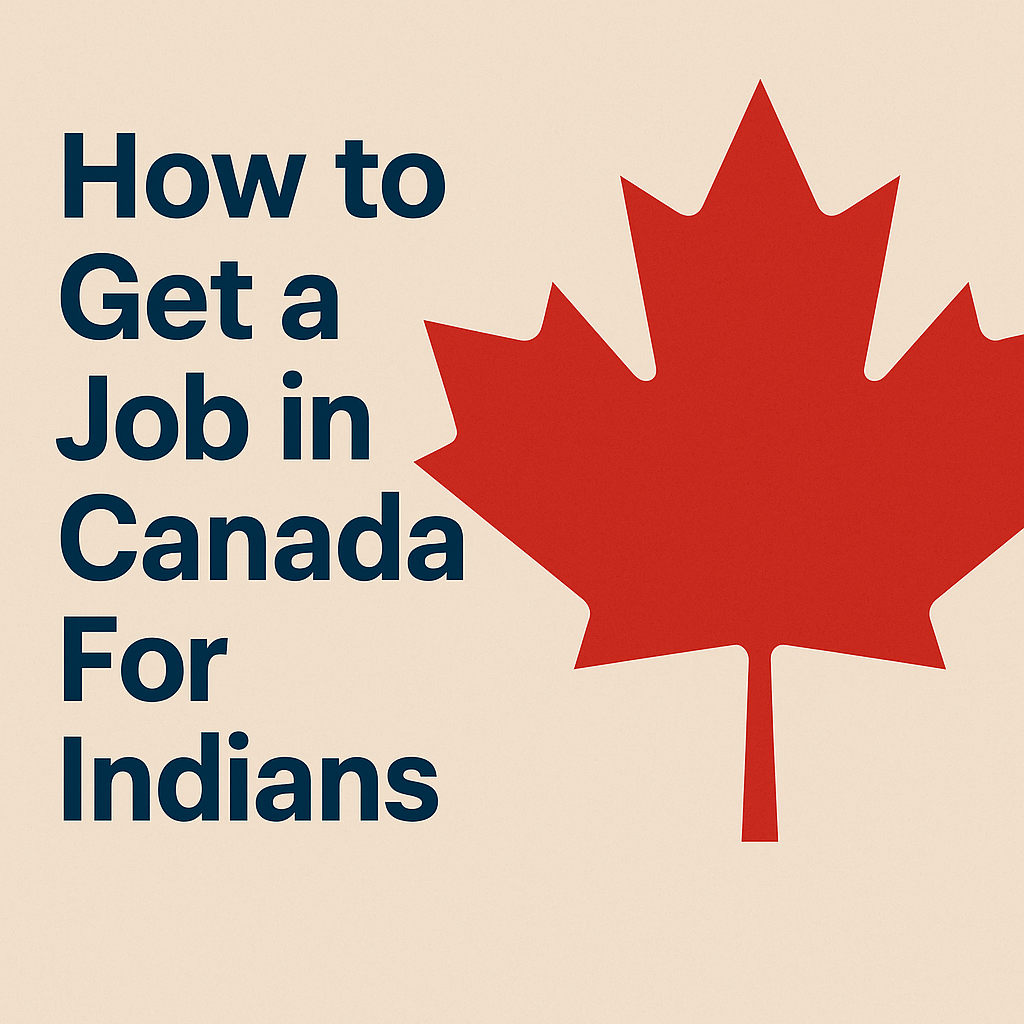
With its high standard of living, excellent healthcare system, multicultural society, and abundant career opportunities, Canada remains one of the most attractive destinations for Indian professionals seeking to work abroad. However, getting a job in Canada as a foreign national involves more than just applying for roles online. You need the right strategy, documents, credentials, and a clear understanding of Canadian immigration pathways.
In this comprehensive guide, we’ll walk you through everything you need to know about how Indians can get a job in Canada, covering job search methods, visa types, resume tips, in-demand occupations, and insider tricks to improve your chances.
Why Work in Canada?
Before diving into the process, let’s explore why so many Indians dream of working in Canada:
- Economic Stability: Canada has a stable economy with a low unemployment rate and consistent demand for skilled workers.
- High Wages: Skilled professionals can earn competitive salaries.
- Permanent Residency Pathways: Work experience in Canada often leads to PR via Express Entry or Provincial Nominee Programs.
- Quality of Life: Universal healthcare, safety, and multicultural communities make it an ideal place to live and raise a family.
Step 1: Understand Work Permit and Immigration Pathways
There are two main ways for Indians to work in Canada:
1. Through a Job Offer (Employer-Sponsored Work Permit)
You get a job from a Canadian employer, and they help you apply for a Labour Market Impact Assessment (LMIA). If approved, you can apply for a work permit.
2. Apply for Permanent Residency (PR)
You apply through Express Entry or other immigration programs. Once you receive an Invitation to Apply (ITA) and get PR, you can work for any employer in Canada.
Types of Canadian Work Permits:
| Type | Description |
|---|---|
| Open Work Permit | Allows you to work for any employer (common for spouses of skilled workers or international students). |
| Employer-Specific Work Permit | Tied to a specific employer and role; requires an LMIA. |
| Post-Graduation Work Permit (PGWP) | Available for students graduating from eligible Canadian institutions. |
Step 2: Choose the Right Immigration Program
1. Express Entry System
The most popular immigration route for skilled professionals. You can apply under:
- Federal Skilled Worker Program (FSWP)
- Canadian Experience Class (CEC)
- Federal Skilled Trades Program (FSTP)
Requirements:
- IELTS score (CLB 7 or higher)
- Education Credential Assessment (ECA)
- At least one year of skilled work experience
Pro Tip: Aim for a CRS score above 470 to stay competitive.
2. Provincial Nominee Programs (PNPs)
Each Canadian province has its own program to attract talent. Some PNPs allow direct application without Express Entry, while others are aligned with it.
Popular PNPs for Indians:
- Ontario Immigrant Nominee Program (OINP)
- British Columbia PNP
- Saskatchewan PNP
3. Global Talent Stream (GTS)
Fast-track program under the Temporary Foreign Worker Program for highly skilled tech professionals. LMIA processing takes just 2 weeks.
Step 3: Build a Canadian-Style Resume and Cover Letter
Canadian employers prefer a clean, concise, and targeted resume. Here’s how to tailor yours:
Resume Format:
- 1-2 pages max
- Use reverse chronological format
- Avoid photos, personal details (marital status, religion, etc.)
Resume Sections:
- Contact Information (No country code needed)
- Professional Summary (3-4 lines)
- Skills
- Work Experience (with measurable achievements)
- Education
- Certifications (if any)
Cover Letter Tips:
- Address it to the hiring manager
- Highlight how your experience aligns with the job
- Keep it within 300–400 words
Step 4: Start Your Job Search
Here are the best platforms to find jobs in Canada from India:
Top Job Portals:
Recruitment Agencies:
- Randstad Canada
- Michael Page Canada
- Hays Canada
- Robert Half
- Drake International
Insider Tips:
- Set job alerts
- Use location filters to target desired provinces
- Customize your resume for every role
- Follow up with employers after submitting applications
Step 5: Network Your Way into the Job Market
In Canada, 80% of jobs are never advertised. They’re filled through internal hiring and referrals. That’s why networking is crucial.
How to Network from India:
- Use LinkedIn: Connect with HR managers and professionals in your field
- Join Facebook Groups for Indians in Canada (job search, immigration, city-specific)
- Attend virtual job fairs and webinars hosted by Canadian employers
- Reach out to Indian alumni from Canadian universities via LinkedIn
Step 6: Upgrade Your Skills and Credentials
Canadian employers value certifications that align with their standards.
Get an Educational Credential Assessment (ECA):
Required for Express Entry. Services include:
- WES (World Education Services)
- ICAS
- CES
- IQAS
In-Demand Certifications:
- PMP (Project Management Professional)
- CPA Canada (for finance professionals)
- AWS/Azure (for cloud professionals)
- Red Seal Certification (for tradespeople)
Learn French (Optional but Valuable)
Especially if targeting Quebec or federal jobs. Aim for CLB 7 or higher in TEF Canada.
Step 7: Prepare for Job Interviews
Once you start getting interview calls, here’s how to crack them:
Common Interview Rounds:
- HR Screening
- Technical Interview
- Behavioral Interview (STAR format)
Tips:
- Research the company thoroughly
- Practice STAR method answers (Situation, Task, Action, Result)
- Prepare for common questions like:
- “Tell me about yourself”
- “Why Canada?”
- “Describe a challenging project you handled”
- Ask insightful questions at the end
Step 8: Watch Out for Job Scams
Unfortunately, there are many scams targeting Indian job seekers. Avoid offers that:
- Ask for money upfront
- Promise visa sponsorship without an interview
- Use unofficial email addresses (e.g., Gmail, Yahoo)
- Don’t provide a legitimate company website
Always verify job offers via Company’s LinkedIn Page, and don’t hesitate to contact their HR directly.
In-Demand Jobs in Canada (2025)
According to the Canadian Job Bank and IRCC, here are the most sought-after roles this year:
| Field | Roles |
|---|---|
| IT | Software Developers, Data Analysts, Cloud Engineers |
| Healthcare | Registered Nurses, Pharmacists, Lab Technicians |
| Engineering | Civil Engineers, Electrical Engineers, Mechanical Engineers |
| Finance | Accountants, Auditors, Financial Analysts |
| Trades | Electricians, Welders, Plumbers |
| Logistics | Truck Drivers, Supply Chain Coordinators |
| Sales & Marketing | Digital Marketers, Business Analysts, Project Managers |
Bonus: Study in Canada to Improve Chances
Many Indians opt for education-to-PR routes. Here’s how:
- Apply to a Designated Learning Institution (DLI)
- Get a Study Permit
- Work part-time while studying
- Get a Post-Graduation Work Permit (PGWP)
- Gain Canadian experience and apply for PR via CEC
FAQs: Indians Working in Canada
Q1. Can I apply for Canadian jobs while living in India?
Yes. You can apply online. A strong resume, LinkedIn presence, and networking help a lot.
Q2. Is IELTS mandatory to work in Canada?
For PR via Express Entry – Yes. For job applications – Not always, but proof of English proficiency can boost your chances.
Q3. Can I get a job without a PR or Work Permit?
No. You must either get a work permit or be a PR holder before starting work legally in Canada.
Q4. How long does it take to get a job in Canada from India?
It varies. Some candidates land roles in 3-6 months; others may take longer depending on their field and strategy.
Final Thoughts
Getting a job in Canada from India isn’t easy, but it’s entirely achievable with the right planning and persistence. Start by identifying the best pathway for your profile—be it Express Entry, a PNP, or employer sponsorship. Then work on creating a standout Canadian-style resume, networking aggressively, and targeting in-demand roles.
Remember, thousands of Indians have successfully made this transition—and you can too. Stay updated with job portals, improve your qualifications, and never give up.
Found this blog helpful? Share it with fellow job seekers or drop your queries in the comments. We’d love to help you make your Canadian dream come true!








